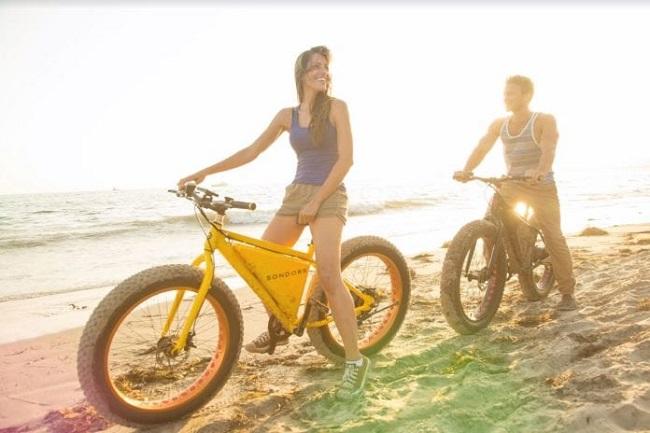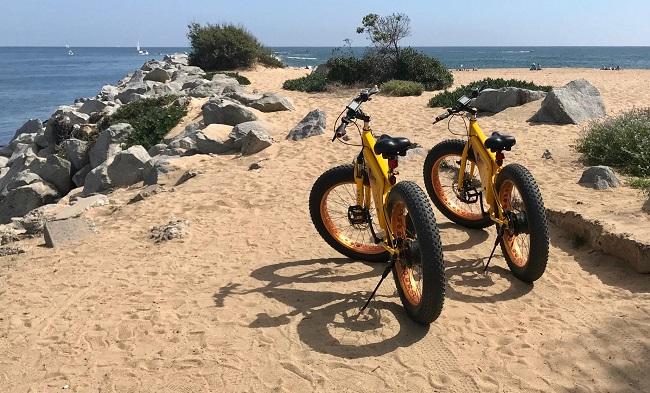It’s a popular misperception that fat bikes, whether ordinary or electric, are just for riding in the snow. I’d say they operate quite well on whatever terrain you throw at them.
After all, what is sand if not snow’s hotter cousin? So listen up, and you’ll be able to make your beach experience a lot simpler.
Why do you really need a fat tire ebike for a ride? Let’s know with me in this article.

Contents
1. Examine the Weather and Tides
Before you leave, figure out how the tides arrive and go to the beach you’re going to so you don’t become stranded with no route back to solid ground. Tides may occur quickly, and you don’t want to be riding on water.
2. Prepare a Pump
You will be riding on diverse terrains coming and departing, so bring a bike pump with you since you will need to test different pressures for different terrains.
Read Also:
3. Commuting
When it comes to choosing an electric bike for commuting, a big tire eBike may not be your first option.
But we believe that is a mistake.
Consider some of the road conditions you could encounter on your journey to and from work.
You will most likely bike on some problematic roads from time to time. Potholes, curb cuts, and gravel may all pose a threat to eBikes with normal width tires (usually 1.75″ to 2.1″ wide), but not to a larger tire. Fat tires are typically 4.0 inches wide, but some are 4.5 inches, and we’ve even seen monster eBikes with 5″ tires.
Nothing is more inconvenient than having to stop on your way to work to repair a flat tire when you are already pressed for time.
a young lady riding a fat tire electric bike to work
When you ride on fat tires, your chances of getting a flat tire are much decreased. Fat tire bikes behave as cushions, gliding over uneven terrain rather than biting into it.
And, with tire pressure ranging from 5 to 30 psi (pounds per square inch), fat tire bikes are ideal for most driving situations.
How to Clean Your E-Bike After a Beach Ride?
While riding your electric bicycle is an exhilarating experience, if you do not take the essential measures before and after the ride, you will harm your bike. Sand, as anybody who has walked on the beach in flip-flops knows, has a habit of flying everywhere.
If you want to ride your electric bike on the beach, you can expect sand to get into the bike’s engine or chain.
While this will not cause immediate harm while riding, you should do a thorough cleaning afterwards to remove any sand accumulation from the engine, chain, wheels, frames, or any other nooks and crannies.
If you disregard the sand, your electric bike will deteriorate over time. When this occurs, you’ll have to disassemble your bike and properly clean, regrease, and reinstall everything.

It’s preferable to save yourself the trouble and clean your electric bicycle after each sand ride.
You may use an air compressor with a nozzle to be more precise in where you’re cleaning sand from the bike, in addition to just brushing the bits of sand off the unclean spots.
This enables you to get up up and personal with the chain, engine, and nooks and crannies of the frame for a thorough clean.
If you don’t have an air compressor, you may use a reverse vacuum or a can of compressed air to assist remove any leftover sand. By eliminating the sand, you’re guaranteeing that your bike stays in top shape ride after ride.
Read Also:
Conclusion
Riding your electric bike along the beach has a distinct feel to it because of the salty air and ocean wind. Have you considered riding your electric bicycle on the beach instead of the boardwalk?
If you’re wondering if you can ride electric bikes in the sand, the answer may surprise you. You certainly can! Electric bikes are legal to ride on most beaches in the United States because federal law considers them to be regular bikes rather than motorized vehicles.






![Err_Connection_Reset Error in Chrome [RESOLVED] Fix Err_Connection_Reset Error in Google Chrome](https://howandwow.info/wp-content/uploads/2019/09/Fix-Err_Connection_Reset-Error-in-Google-Chrome.jpg)
![DNS_Probe_Finished_No_Internet Error [RESOLVED] Fix DNS_Probe_Finished_No_Internet Error](https://howandwow.info/wp-content/uploads/2019/09/Fix-DNS_Probe_Finished_No_Internet-Error.jpg)

![Err_Cache_Miss in Google Chrome Error [RESOLVED] Err_Cache_Miss in Google Chrome Error](https://howandwow.info/wp-content/uploads/2019/08/How-to-Fix-Confirm-Form-Resubmission-Error.jpg)






![Steam Missing File Privileges Error [RESOLVED] How to Fix Steam Missing File Privileges](https://howandwow.info/wp-content/uploads/2020/07/How-to-Fix-Steam-Missing-File-Privileges-Error-100x70.jpg)




![SIM Not Provisioned MM#2 Error [RESOLVED] SIM Not Provisioned MM#2](https://howandwow.info/wp-content/uploads/2020/03/SIM-Not-Provisioned-MM2.jpg)






